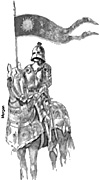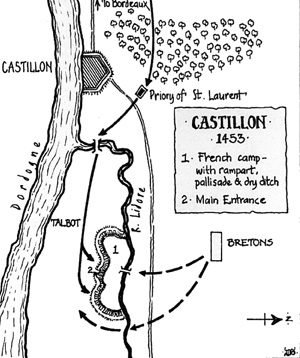
THE BATTLE
As dawn broke on the morning of July 17th, Talbot's little force reached the woods which lay to the north of the Priry. The French garrison probably had their attention on the road which ran to the west, and were in any case likely to have been half-asleep. They were surprised and overwhelmed by the English soldiers who swept down on them out of the woods, but a few survivors escaped to carry news of the English approach to Bureau and his main force.
With the Priory in his hands, Talbot had now to decide on his next move. His first action was to despatch an experienced commander, Sir Thomas Evringham, to discover the nature of the French camp. He had rejected the notion of launching an immediate assault, for the troops with him were hungry, and needed at least a brief rest, and, as there was now no chance of surprising the enemy, he hoped to give time for his main force to come up.
Whilst his men snatched a hasty breakfast, Talbot himself prepared to celebrate Mass, but, before he could begin, a scout arrived claiming that the French in the ere pouring across the Lidore in full retreat.
Sir Thomas Evringham, returning, said that he had seen no such signs, but admitted that he had not been able to observe all of the enemy position. He urged his commander to await the arrival of the remainder of their force before attacking. Talbot, however, feared that if he waited, the enemy might retreat and break off contact. Believing that the enemy camp was already half-evacuated, he made his decision. He would launch an immediate attack. Saying "I will hear Mass when I have defeated the enemy", Talbot ordered his trumpeter to sound the advance.
Because of his oath, Talbot was still not wearing armour. Riding his grey cob, he was dressed in a scarlet doublet and a velvet cap, and was surrounded by his bodyguard, all men recruited on his family estates around Whitchurch in Shropshire. Talbot led his little force, riding at the gallop, down the slope towards the point where the Rivers Dordogne and Lidore joined, over a ford, and then for 500 yards followed the course of a sunken lane along the river bank, before wheeling left on to the plain where the French camp was situated. Talbot had decided to attack the southern face of Bureau's position, even though this meant that he would be fighting with the Dordogne at his back, 600 yards away.
As the French camp came into sight, the English commanders realised that their intelligence had been false. Far from retreating (the movements reported by the scout had probably only been some horses and excess baggage being sent to the rear), the enemy were standing firm, and their ramparts were bristling with guns. These weapons, often described as "artillery", were in fact mostly hand guns, or "batons-a-feu", with brass or bronze barrels and wooden stocks. Aimed from the chest, they fired a lead bullet, by means of a type of matchlock known as a "serpentine".
Despite being faced by odds of six to one, Talbot did not hesitate - it was probably too late to retreat in any case. He ordered his men to dismount, and then, whilst he himself remained on horseback to direct operations, sounded the "Advance". The English troops unfurled their banners, some apparently bearing rude inscriptions about the French king, and, shouting their war cry of "Talbot! St George!", surged forwards towards the enemy ramparts. The French guns opened fire at a range of about 200 yards, and their shot tore gaps in the lines of Talbot's men, but failed to halt their advance.
Closing their ranks, The English troops quickened their advance and broke into a charge. Desperate hand-to-hand fighting broke out along the line of the fortifications and in the dry ditch, into which Talbot's men jumped and then made furious attempts to scale the parapet. Here and there, some succeeded, among them Sir Thomas Evringham, who broke in near the gateway, and planted his banner on the ramparts as a rallying point, but was immediately killed. All the while, the French guns kept up their deadly fire, it being recorded that on one occasion as many as six men were struck down by a single shot.
After the fighting had continued for about an hour, the first troops of the English main body, commanded by Lord Kendall, began to appear, crossing the Lidore on the English left. Talbot ordered them to attack the French right, and threw in other units piecemeal as they came on the scene, but the bulk were apparently still some distance away. Eventually about 4,000 English troops were probably engaged, though without any artillery, such guns as Talbot may have possessed not reaching the field in time.
Reinforced, Talbot's men once again gained a foothold on the ramparts, but now the Breton troops from the north bank of the Lidore intervened. Crossing the river to the south, they crashed into the English right flank. Talbot hastily led some of his men to counter the new threat, but at the same moment Bureau launched a general frontal assault on the English forces.
Step by step, Talbot and his men were forced back towards the Garonne. Abandoning his vow not to bear arms, Talbot drew his sword, and with his son and his bodyguard, attempted to organise a stand to cover the retreat of the survivors of his army over the ford at Pas de Rozan. Talbot urged Lisle to flee whilst there was still time but his son refused to leave him. Then Talbot's grey cob was struck by a bullet, and momentarily fell, pinning Talbot beneath it. Before the old English veteran could get to his feet, he was surrounded and killed with an axe blow to the head by a French archer named Michel Perunin. Although a few of the English army escaped, most were either drowned, or, like Lord Lisle, went down fighting.
Talbot's body was identified next day by a missing tooth, and buried with honours by the French. As one of their chroniclers observed: " Such was the end of this famous and renowned English leader who for so long had been one of the most formidable thorn the side of the French, who regarde him with terror and dismay." They could afford to be generous, for, without Talbot, English Gascony was doomed. Bordeaux surrendered on October 10th, and (though no peace treaty has been signed to this day) the Hundred Years' War was finally over.
WARGAMING CASTILLON
 The Battle of Castillon provides an
interesting opportunity to match two
contrasting weapon systems, one which
had been supreme in Western Europe for
over a century, and the other whose day
was just dawning. The campaign as a
whole makes a challenging situation for
both players, in which the French have the
advantage of numbers, but must act
aggressively if they are to win. They will in
the process inevitably provide opportunities
for a skilful and daring English opponent
with a smaller but high-quality army, and
the advantage of interior lines. Whoever
holds Bordeaux at the end of the game, wins.
The Battle of Castillon provides an
interesting opportunity to match two
contrasting weapon systems, one which
had been supreme in Western Europe for
over a century, and the other whose day
was just dawning. The campaign as a
whole makes a challenging situation for
both players, in which the French have the
advantage of numbers, but must act
aggressively if they are to win. They will in
the process inevitably provide opportunities
for a skilful and daring English opponent
with a smaller but high-quality army, and
the advantage of interior lines. Whoever
holds Bordeaux at the end of the game, wins.
If wargaming Castillon itself, the following information may be useful.
RULES
There are several suitable commercial sets of rules available. The ratings etc. given here are based on those in Alan Cook's "Lance" (Tabletop Games, 3rd ed. 1982), but others can equally well be used. Each figure represents 20 men.
ENGLISH ARMY
Army Leader: John Talbot, Earl of Shrewsbury (Leader Value 3) May not engage in melee combat until English Player throws a "6" ( One attempt at the start of each English Player Turn), or is attacked. (This represents the inhibiting effect of Talbot's oath to the French King). He should also have a greater possibility of being a casualty lack of armour).
FORCE "A"
Battle Leader : Lord Lisle (Leader Value 2) (Talbot may also act as Battle Leader).
- 5 Super Heavy Infantry
5 Extra Heavy Infantry
15 Medium Infantry
40 Light Infantry (Longbowmen)
All should be classed as "Regular" troops.
Force "A" enters anywhere on the north side of the table on Turn 1.
FORCE B
Battle Leader: Lord Kendall (Leader Value 2)
- 2 Super Heavy Infantry
5 Extra Heavy Infantry
10 Medium Infantry
200 Light Infantry (Longbowmen)
All are "regulars". Force "B" enters on the Northern edge of the table on any English Player Turn after turn 3 on a dice result of "5" or "6". All English troops are Morale Class A.
FRENCH ARMY
Army Leader: Jean Bureau (Leader Value 3) Also commands Main Force,
MAIN FORCE
- 15 Super Heavy Infantry
20 Extra Heavy Infantry
40 Heavy Infantry
100 Light Infantry (Crossbowmen)
100 Light Infantry (Longbowmen)
300 Light Infantry (Mixed Weapons)
60 Light Guns
All are "regulars". Super, Extra, and Heavy Infantry are Morale Class "A", the remainder Morale Class "B". All are in Camp, which rates as "Prepared Defences".
Force "B" (Stationed in Priory at start of Game)
Battle Leader: (Unnamed, LV 1)
- 30 Light Infantry "Regulars", Morale Class "B"
Force "C" (Bretons) Stationed as on map. Battle Leader: Comte de Penthievre (Leader Value 2)
- 5 Super Heavy Infantry
10 Heavy Infantry
35 Light Infantry (Mixed Weapons)
All "regulars", Morale Class "B".
Special Rule
No French unit may move before any unit is attacked by English. Five turns later, all un-attacked French units may begin to move normally.
Victory conditions will *based upon holding the French camp at the end of the game, and on casualties inflicted.
Thanks to Osprey for permission to use the illustration by Graham Turner from MAA 33.7 'Henry V and the Conquest of France 1416-53 by Paul Knight.
Sources
Alfred E. Burne: The Agincourt War, 1949
Desmond Stwart: The Hundred Years War, 1978
Hugh Talbot: The English Achilles, 1981
Death of a Legend: The Battle of Castillon
Back to Battlefields Vol. 1 Issue 7 Table of Contents
Back to Battlefields List of Issues
Back to Master Magazine List
© Copyright 1999 by Partizan Press.
This article appears in MagWeb (Magazine Web) on the Internet World Wide Web.
Other military history articles and gaming articles are available at http://www.magweb.com